Alternate Route Handbook
6. Traffic Management Planning
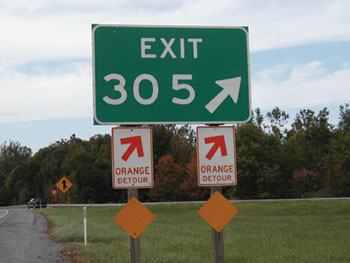 |
| Figure 6-1. Color-coded alternate route trailblazer sign. |
INTRODUCTION
The third phase in the alternate route planning process is traffic management planning. Three tasks associated with traffic management planning include:
- Determine information dissemination methods to notify motorists of the alternate route.
- Determine information dissemination methods to guide motorists along alternate route.
- Determine traffic control measures to be implemented on alternate route.
DETERMINE INFORMATION DISSEMINATION METHODS TO NOTIFY MOTORISTS OF THE ALTERNATE ROUTE
Motorists must be notified when a major incident occurs, and be provided information on available alternate routes a sufficient distance upstream of the diversion point. Although agencies establish different guidelines regarding what information should be disseminated, the three types of information to be disseminated include (1) a mandatory diversion message, (2) a voluntary diversion message, or (3) information on traffic conditions only, leaving motorists to determine whether to divert from the primary route to an alternate route.
An example of a mandatory message is "Major delays ahead, divert to alternate route." An example of a voluntary message is "Major delays ahead, minor delays on alternate route." The dissemination of a mandatory message when conditions on the alternate route have significantly deteriorated affects the credibility of future CMS announcements. Figure 6-2 shows examples of mandatory and voluntary messages. A traffic condition information method often indicates the number of lanes blocked by a traffic incident in order for motorists to gain a sense of the severity of the situation.
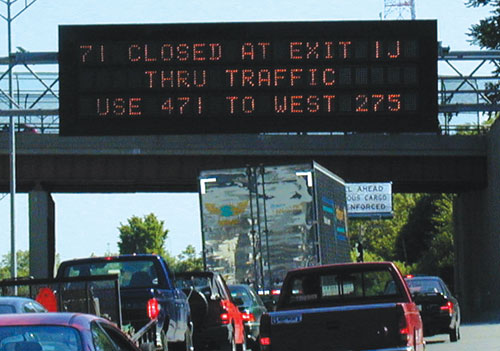 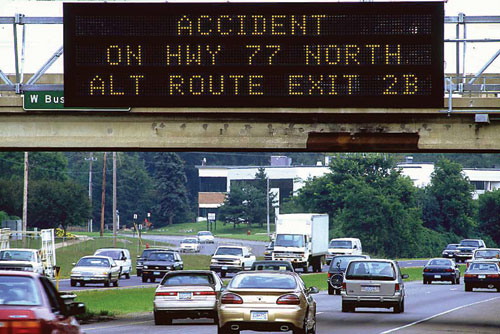 |
| Figure 6-2. Mandatory and voluntary alternate route signage. |
Three common sources of disseminating traveler information are CMSs, HAR, and media sources.
- Changeable message signs are electronic signs located above or alongside the roadway, which allow multiple messages to be displayed to motorists. CMSs can be either permanent or portable. Portable CMSs are especially useful for traffic management during alternate route implementation. The FHWA Portable Changeable Message Sign Handbook1 discusses guidelines for the use
of portable CMSs under incident conditions. CMSs provide information to all passing motorists at a precise location. Figure 6-3 shows an example of using a CMS to notify passing motorists of a downstream freeway closure.
- Highway advisory radio represents another commonly used method for disseminating en-route information to motorists. HAR is useful for providing area-wide messages, rather than just at a single point. HAR messages can be more detailed than CMS messages. Both permanent and portable HAR are available.
- Other methods that are used, especially in areas where CMSs and HAR have not been implemented and portable devices are not available, include (1) positioning a traffic control officer at a diversion point in order to direct traffic to/from an alternate route, (2) deployment of temporary static signs, and (3) media sources, such as television and radio, that can be used to provide both pre-trip and en-route traveler information.
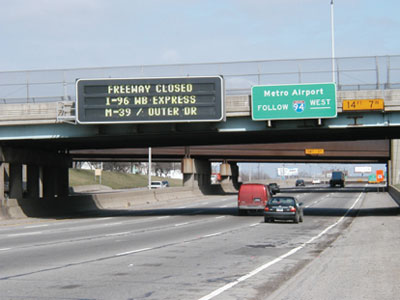 |
| Figure 6-3. CMS informing drivers of a freeway closure. |
Two general methods of information dissemination include en-route and pre-trip. Table 6-1 provides examples of each category.
Table 6-1. Methods of information dissemination
| METHOD | PURPOSE | EXAMPLES |
|---|---|---|
| En-route- |
|
|
| roadside |
|
|
| En-route- |
|
|
| in-vehicle |
|
|
| Pre-trip |
|
|
In addition to en-route traveler information, it is also useful to provide motorists with pre-trip information on regional traffic conditions and alternate routes. In turn, this information influences the utility associated with choosing to travel via a particular mode and/or at a given time. Many agencies provide press releases to local broadcast media in real-time that describe new or ongoing road closures or restrictions and the alternate routes that are available. Radio and television traffic reports, as well as telephone information systems, also provide up-to-date traveler information. The radio represents a valuable source for traffic information, since it may be accessed either pre-trip or en-route.
In recent years, as Internet use has grown dramatically, many agencies provide Web sites with real-time traffic information. Public agency Web sites may include up-to-the-minute information on traffic conditions, incident characteristics, and recommended alternate routes.
Telephone information systems (e.g., 511) represent another information source that may be used for either pre-trip or en-route information. Information on the application and configuration of 511 for incident conditions is available in 511: America's Travel Information Number: Implementation and Operational Guidelines for 511 Services.2 The document includes guidelines and procedures for disseminating information on traffic conditions, public transit operations, and weather, and is applicable to both metropolitan areas and urban/rural areas.
Table 6-2 describes the role of stakeholders involved in disseminating traveler information.
Table 6-2. Stakeholder involvement for determining information dissemination methods for notifying motorists of an alternate route
| STAKEHOLDER | ROLE |
|---|---|
| Transportation/public works agency |
|
| Law enforcement |
|
| Transit agency |
|
| Turnpike/toll authority |
|
Minimum Actions for Determining Information Dissemination Methods to Notify Motorists of the Alternate Route
Minimum actions for determining information dissemination methods to notify motorists of the alternate route include:
- Use traffic control officers and temporary signage on the primary route to notify motorists that the road is closed and that an alternate route exists. Associated considerations include:
- In areas where little or no ITS infrastructure is in place or for short-term deployment, law enforcement officers may be used as the primary method of notifying motorists of the existence of an alternate route. Traffic control officers play a significant role in maximizing operating efficiency at primary route/alternate route connection points. By using positive traffic control, as illustrated in figure 6-4, officers guide motorists from the primary route to the alternate route. This minimizes headway between vehicles and reduces the potential for stop-and-go traffic due to driver confusion. Also, the active presence of the traffic control officer commands motorists' attention.
- If an agency has portable signs (either portable static signs or portable CMSs), then the devices should be deployed in order to notify upstream motorists that the road is closed and the motorists must divert to a designated alternate route. Incident response teams should carry temporary portable signs in their trucks to be deployed in case an incident warrants.
- The locations where temporary portable signs are to be deployed should be detailed in the alternate route plan.
- In areas where little or no ITS infrastructure is in place or for short-term deployment, law enforcement officers may be used as the primary method of notifying motorists of the existence of an alternate route. Traffic control officers play a significant role in maximizing operating efficiency at primary route/alternate route connection points. By using positive traffic control, as illustrated in figure 6-4, officers guide motorists from the primary route to the alternate route. This minimizes headway between vehicles and reduces the potential for stop-and-go traffic due to driver confusion. Also, the active presence of the traffic control officer commands motorists' attention.
- Use existing information dissemination sources (such as CMSs, HAR, 511, media, and the Internet) to provide traffic information where appropriate. Associated considerations
include:
- Information devices and other sources used in the day-to-day management of transportation system operations should be used to notify motorists of an incident and any designated alternate routes.
- If portable CMSs are used, then consult the FHWA Portable Changeable Message Sign Handbook, which contains guidelines on the use of portable CMSs in incident conditions.1
- If permanent CMSs are used, then consult the FHWA Guidelines for Changeable Message Sign Messages.3 The document contains guidelines for the development of CMS messages that support alternate route deployment. Stakeholders who plan to develop special CMS message sets for inclusion in an alternate route plan should consult this document.
- Information devices and other sources used in the day-to-day management of transportation system operations should be used to notify motorists of an incident and any designated alternate routes.
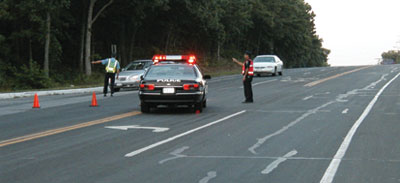 |
| Figure 6-4. Law enforcement diverting traffic. |
Ideal Actions for Determining Information Dissemination Methods to Notify Motorists of the Alternate Route
The following ideal actions may be applied in addition to the minimum actions:
- Use alternative information dissemination methods (e.g., en-route and pre-trip) to notify motorists of the alternate route in order to reach everyone affected. If law enforcement provides information dissemination, then the law enforcement agency must understand and agree to their responsibilities and have adequate personnel to perform their tasks.
- If an alternate route is implemented for a long-term period, then consider disseminating information to encourage travelers to (1) switch to public transit as an alternative to driving, (2) modify their trip time or destination, or (3) carpool. A major incident, such as a bridge collapse, may require the use of a long-term alternate route plan. During this time, travelers should be encouraged to carpool or use alternative forms of transportation, if available and sensible, that reduce traffic volume in the corridor served by the alternate route. The media may be used to disseminate traffic demand management initiatives to a large audience.
DETERMINE INFORMATION DISSEMINATION METHODS TO GUIDE MOTORISTS ALONG THE ALTERNATE ROUTE
After diverting to an alternate route, motorists must be provided with adequate information in order to navigate the alternate route to the point where the alternate route connects to the primary route.
Typically, trailblazer signs guide motorists along the alternate route and back to the primary route, connecting at some point downstream of the incident site. Examples of types of signs and trailblazers include:
- Permanent trailblazers erected along an alternate route that is frequently used.
- Blank-out trailblazers or route marker signs with electronic changeable arrows.
- Permanently mounted flip signs (facing opposing traffic when not in use, flipped by traffic control officers to face traffic when in use).
- Fold-out signs.
- Color-coded trailblazers (i.e., "blue route").
- Permanent or portable CMSs.
Table 6-3 describes the role of stakeholders involved in disseminating traveler information.
Table 6-3. Stakeholder involvement in determining information dissemination methods to guide motorists along alternate route
| STAKEHOLDER | ROLE |
|---|---|
| Transportation/public works agency |
|
| Law enforcement |
|
| Turnpike/toll authority |
|
(Chapter 6 is continued on next page.)